Dye Dale, O`neill Robert. The road to victory: From Pearl Harbor to Okinawa
Подождите немного. Документ загружается.

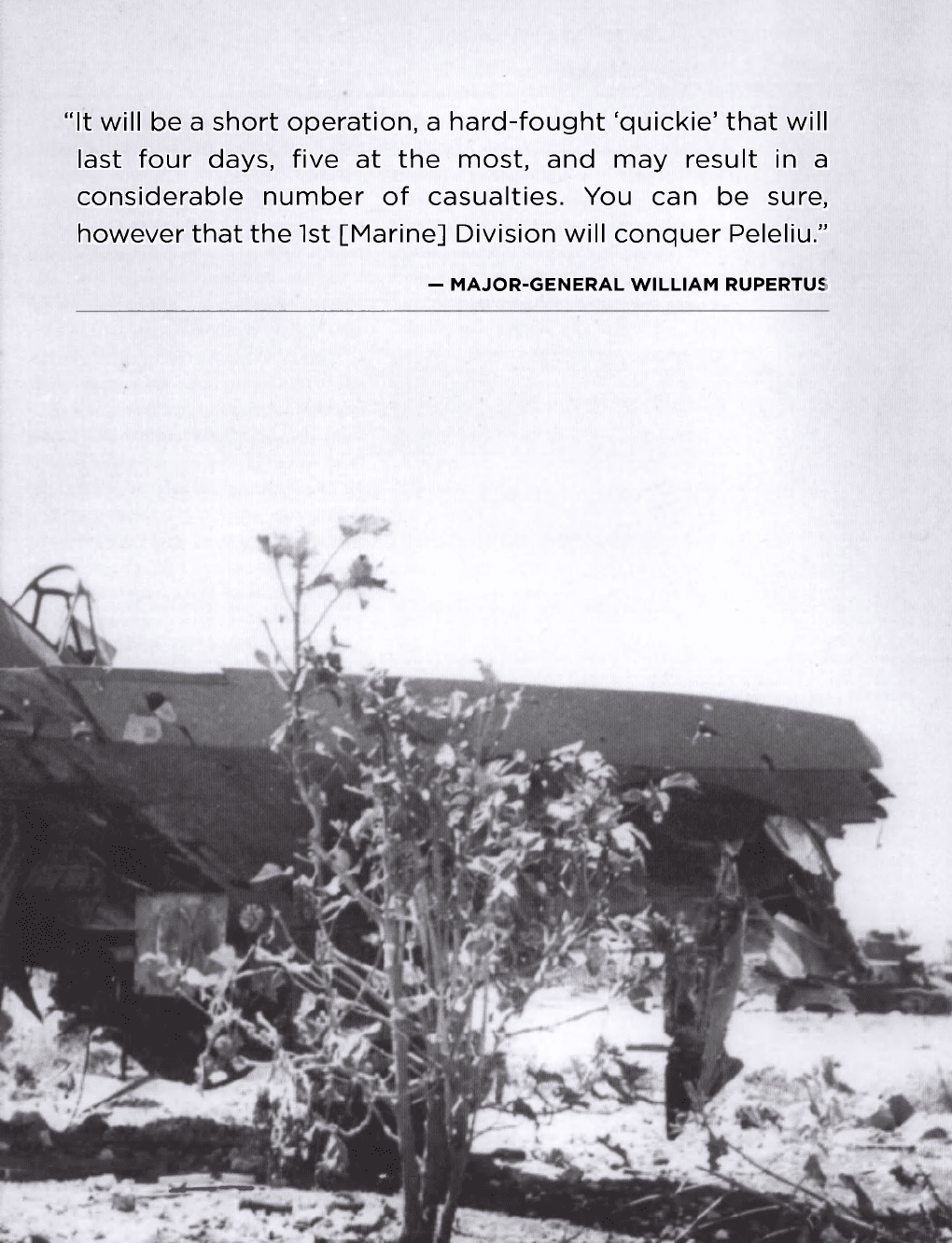
"It will be a short operation, a hard-fought 'quickie' that will
last four days, five at the most, and may result in a
considerable number of casualties. You can be sure,
however that the 1st [Marine] Division will conquer Peleliu."
- MAJOR-GENERAL WILLIAM RUPERTUS
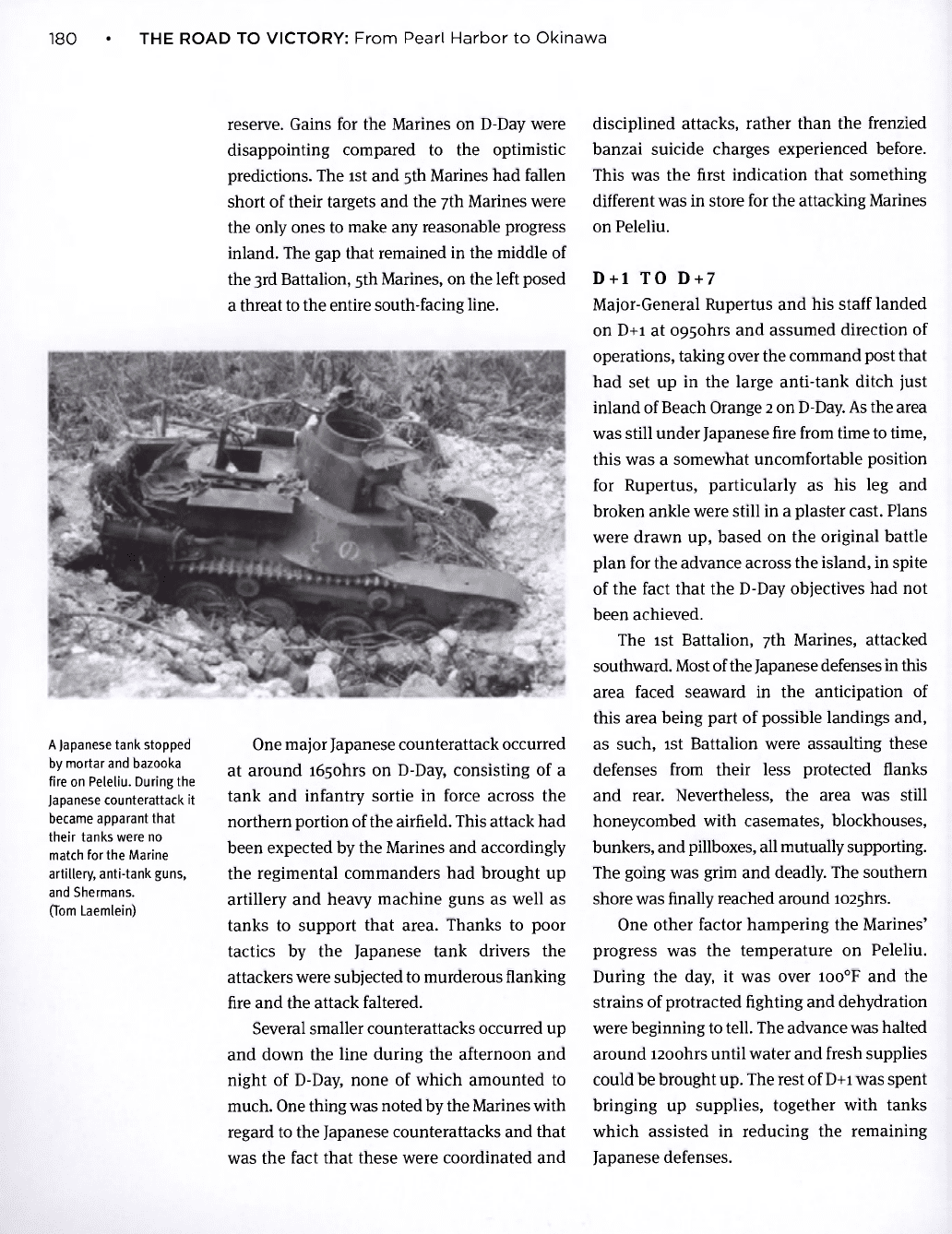
180 • THE ROAD TO VICTORY: From Pearl Harbor to Okinawa
reserve. Gains for the Marines on D-Day were
disappointing compared to the optimistic
predictions. The ist and 5th Marines had fallen
short of their targets and the 7th Marines were
the only ones to make any reasonable progress
inland. The gap that remained in the middle of
the 3rd Battalion, 5th Marines, on the left posed
a threat to the entire south-facing line.
A Japanese tank stopped
by mortar and bazooka
fire on Peleliu. During the
Japanese counterattack it
became apparantthat
their tanks were no
match for the Marine
artillery, anti-tank guns,
and Shermans.
(Tom Laemlein)
One major Japanese counterattack occurred
at around i6sohrs on D-Day, consisting of a
tank and infantry sortie in force across the
northern portion of the airfield. This attack had
been expected by the Marines and accordingly
the regimental commanders had brought up
artillery and heavy machine guns as well as
tanks to support that area. Thanks to poor
tactics by the Japanese tank drivers the
attackers were subjected to murderous flanking
fire and the attack faltered.
Several smaller counterattacks occurred up
and down the line during the afternoon and
night of D-Day, none of which amounted to
much. One thing was noted by the Marines with
regard to the Japanese counterattacks and that
was the fact that these were coordinated and
disciplined attacks, rather than the frenzied
banzai suicide charges experienced before.
This was the first indication that something
different was in store for the attacking Marines
on Peleliu.
D+l TO D+7
Major-General Rupertus and his staff landed
on D+i at 0950hrs and assumed direction of
operations, taking over the command post that
had set up in the large anti-tank ditch just
inland of Beach Orange 2 on D-Day. As the area
was still under Japanese fire from time to time,
this was a somewhat uncomfortable position
for Rupertus, particularly as his leg and
broken ankle were still in a plaster cast. Plans
were drawn up, based on the original battle
plan for the advance across the island, in spite
of the fact that the D-Day objectives had not
been achieved.
The 1st Battalion, 7th Marines, attacked
southward. Most of the Japanese defenses in this
area faced seaward in the anticipation of
this area being part of possible landings and,
as such, 1st Battalion were assaulting these
defenses from their less protected flanks
and rear. Nevertheless, the area was still
honeycombed with casemates, blockhouses,
bunkers, and pillboxes, all mutually supporting.
The going was grim and deadly. The southern
shore was finally reached around i025hrs.
One other factor hampering the Marines'
progress was the temperature on Peleliu.
During the day, it was over ioo°F and the
strains of protracted fighting and dehydration
were beginning to tell. The advance was halted
around i200hrs until water and fresh supplies
could be brought up. The rest of D+i was spent
bringing up supplies, together with tanks
which assisted in reducing the remaining
Japanese defenses.
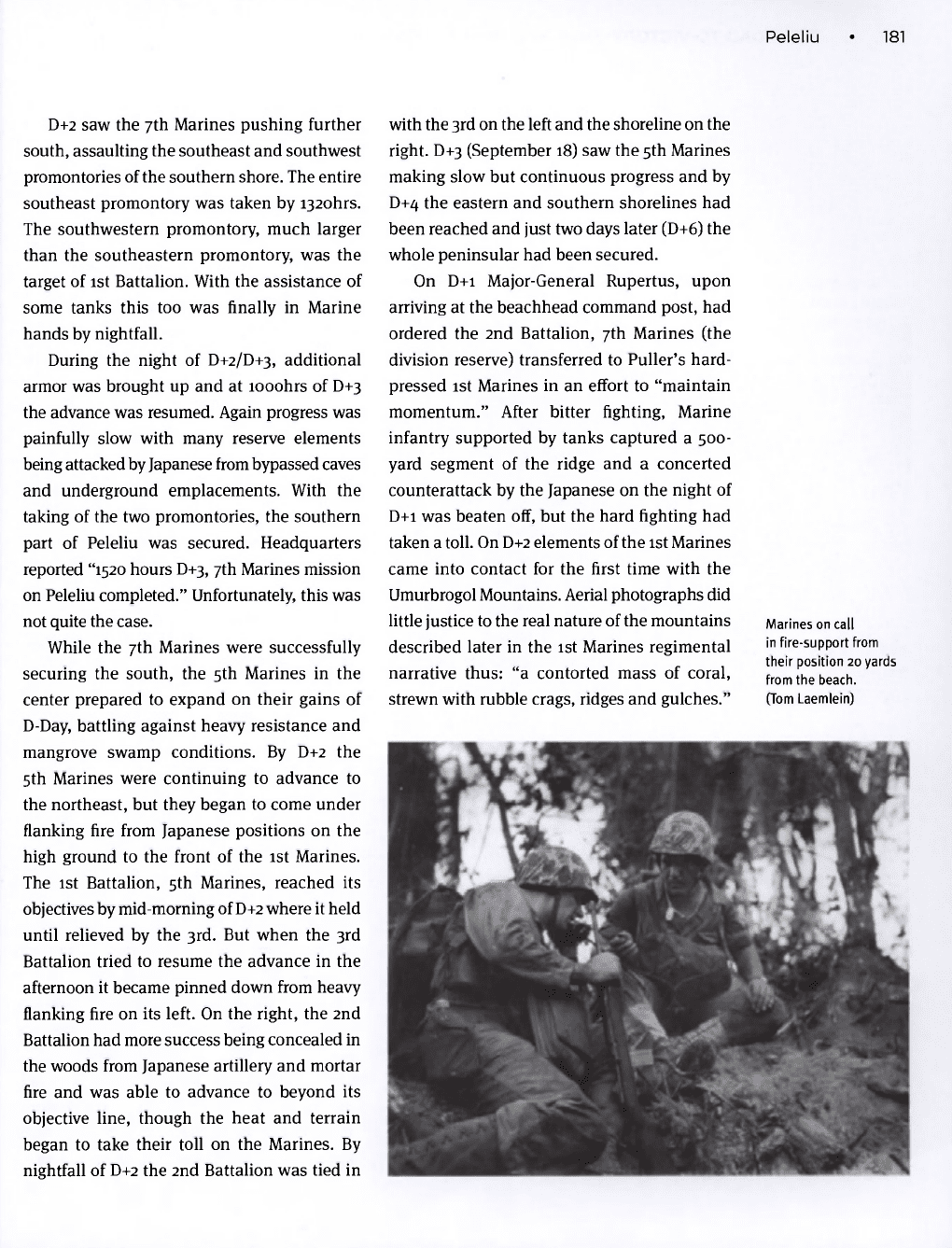
Peleliu • 181
D+2 saw the 7th Marines pushing further
south, assaulting the southeast and southwest
promontories of the southern shore. The entire
southeast promontory was taken by i32ohrs.
The southwestern promontory, much larger
than the southeastern promontory, was the
target of 1st Battalion. With the assistance of
some tanks this too was finally in Marine
hands by nightfall.
During the night of D+2/D+3, additional
armor was brought up and at looohrs of D+3
the advance was resumed. Again progress was
painfully slow with many reserve elements
being attacked by Japanese from bypassed caves
and underground emplacements. With the
taking of the two promontories, the southern
part of Peleliu was secured. Headquarters
reported "1520 hours D+3, 7th Marines mission
on Peleliu completed." Unfortunately, this was
not quite the case.
While the 7th Marines were successfully
securing the south, the 5th Marines in the
center prepared to expand on their gains of
D-Day, battling against heavy resistance and
mangrove swamp conditions. By D+2 the
5th Marines were continuing to advance to
the northeast, but they began to come under
flanking fire from Japanese positions on the
high ground to the front of the 1st Marines.
The 1st Battalion, 5th Marines, reached its
objectives by mid-morning of
D+2
where it held
until relieved by the 3rd. But when the 3rd
Battalion tried to resume the advance in the
afternoon it became pinned down from heavy
flanking fire on its left. On the right, the 2nd
Battalion had more success being concealed in
the woods from Japanese artillery and mortar
fire and was able to advance to beyond its
objective line, though the heat and terrain
began to take their toll on the Marines. By
nightfall of D+2 the 2nd Battalion was tied in
with the 3rd on the left and the shoreline on the
right. D+3 (September 18) saw the 5th Marines
making slow but continuous progress and by
D+4 the eastern and southern shorelines had
been reached and just two days later (D+6) the
whole peninsular had been secured.
On D+i Major-General Rupertus, upon
arriving at the beachhead command post, had
ordered the 2nd Battalion, 7th Marines (the
division reserve) transferred to Puller's hard-
pressed 1st Marines in an effort to "maintain
momentum." After bitter fighting, Marine
infantry supported by tanks captured a 500-
yard segment of the ridge and a concerted
counterattack by the Japanese on the night of
D+i was beaten off, but the hard fighting had
taken a toll. On D+2 elements of the 1st Marines
came into contact for the first time with the
Umurbrogol Mountains. Aerial photographs did
little justice to the real nature of the mountains
described later in the 1st Marines regimental
narrative thus: "a contorted mass of coral,
strewn with rubble crags, ridges and gulches."
Marines on call
in fire-support from
their position 20 yards
from the beach.
(Tom Laemlein)
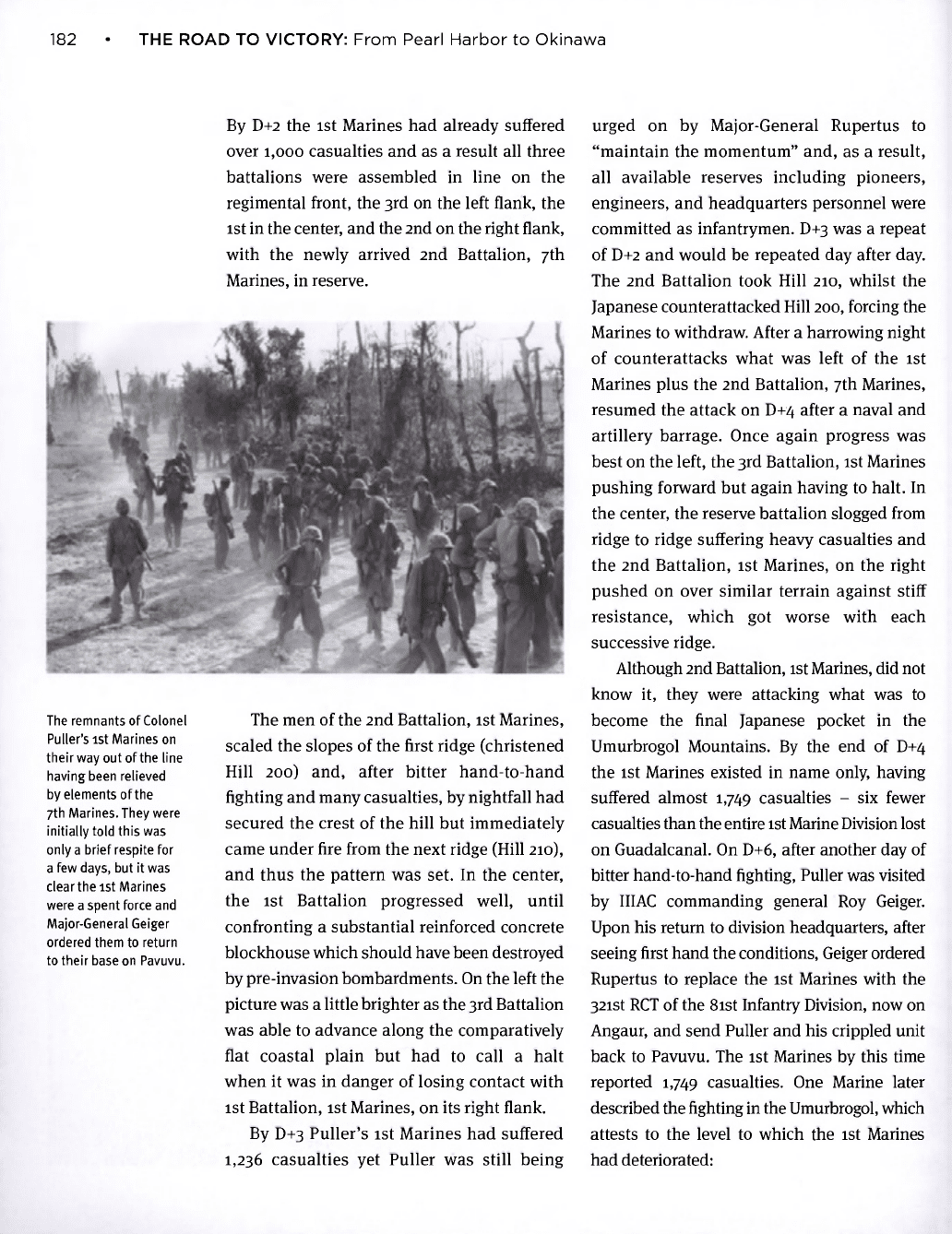
182 • THE ROAD TO VICTORY: From Pearl Harbor to Okinawa
By D+2 the ist Marines had already suffered
over 1,000 casualties and as a result all three
battalions were assembled in line on the
regimental front, the 3rd on the left flank, the
1st in the center, and the 2nd on the right flank,
with the newly arrived 2nd Battalion, 7th
Marines, in reserve.
The remnants of Colonel
Puller's 1st Marines on
their way out of the line
having been relieved
by elements of the
7th Marines. They were
initially told this was
only a brief respite for
a few days, but it was
clear the 1st Marines
were a spent force and
Major-General Geiger
ordered them to return
to their base on Pavuvu.
The men of the 2nd Battalion, 1st Marines,
scaled the slopes of the first ridge (christened
Hill 200) and, after bitter hand-to-hand
fighting and many casualties, by nightfall had
secured the crest of the hill but immediately
came under fire from the next ridge (Hill 210),
and thus the pattern was set. In the center,
the 1st Battalion progressed well, until
confronting a substantial reinforced concrete
blockhouse which should have been destroyed
by pre-invasion bombardments. On the left the
picture was a little brighter as the 3rd Battalion
was able to advance along the comparatively
flat coastal plain but had to call a halt
when it was in danger of losing contact with
1st Battalion, 1st Marines, on its right flank.
By D+3 Puller's 1st Marines had suffered
1,236 casualties yet Puller was still being
urged on by Major-General Rupertus to
"maintain the momentum" and, as a result,
all available reserves including pioneers,
engineers, and headquarters personnel were
committed as infantrymen. D+3 was a repeat
of D+2 and would be repeated day after day.
The 2nd Battalion took Hill 210, whilst the
Japanese counterattacked Hill 200, forcing the
Marines to withdraw. After a harrowing night
of counterattacks what was left of the 1st
Marines plus the 2nd Battalion, 7th Marines,
resumed the attack on D+4 after a naval and
artillery barrage. Once again progress was
best on the left, the 3rd Battalion, 1st Marines
pushing forward but again having to halt. In
the center, the reserve battalion slogged from
ridge to ridge suffering heavy casualties and
the 2nd Battalion, 1st Marines, on the right
pushed on over similar terrain against stiff
resistance, which got worse with each
successive ridge.
Although 2nd Battalion, 1st Marines, did not
know it, they were attacking what was to
become the final Japanese pocket in the
Umurbrogol Mountains. By the end of D+4
the 1st Marines existed in name only, having
suffered almost 1,749 casualties - six fewer
casualties than the entire 1st Marine Division lost
on Guadalcanal. On D+6, after another day of
bitter hand-to-hand fighting, Puller was visited
by IIIAC commanding general Roy Geiger.
Upon his return to division headquarters, after
seeing first hand the conditions, Geiger ordered
Rupertus to replace the 1st Marines with the
321st RCT of the 81st Infantry Division, now on
Angaur, and send Puller and his crippled unit
back to Pavuvu. The 1st Marines by this time
reported 1,749 casualties. One Marine later
described the fighting in the Umurbrogol, which
attests to the level to which the 1st Marines
had deteriorated:
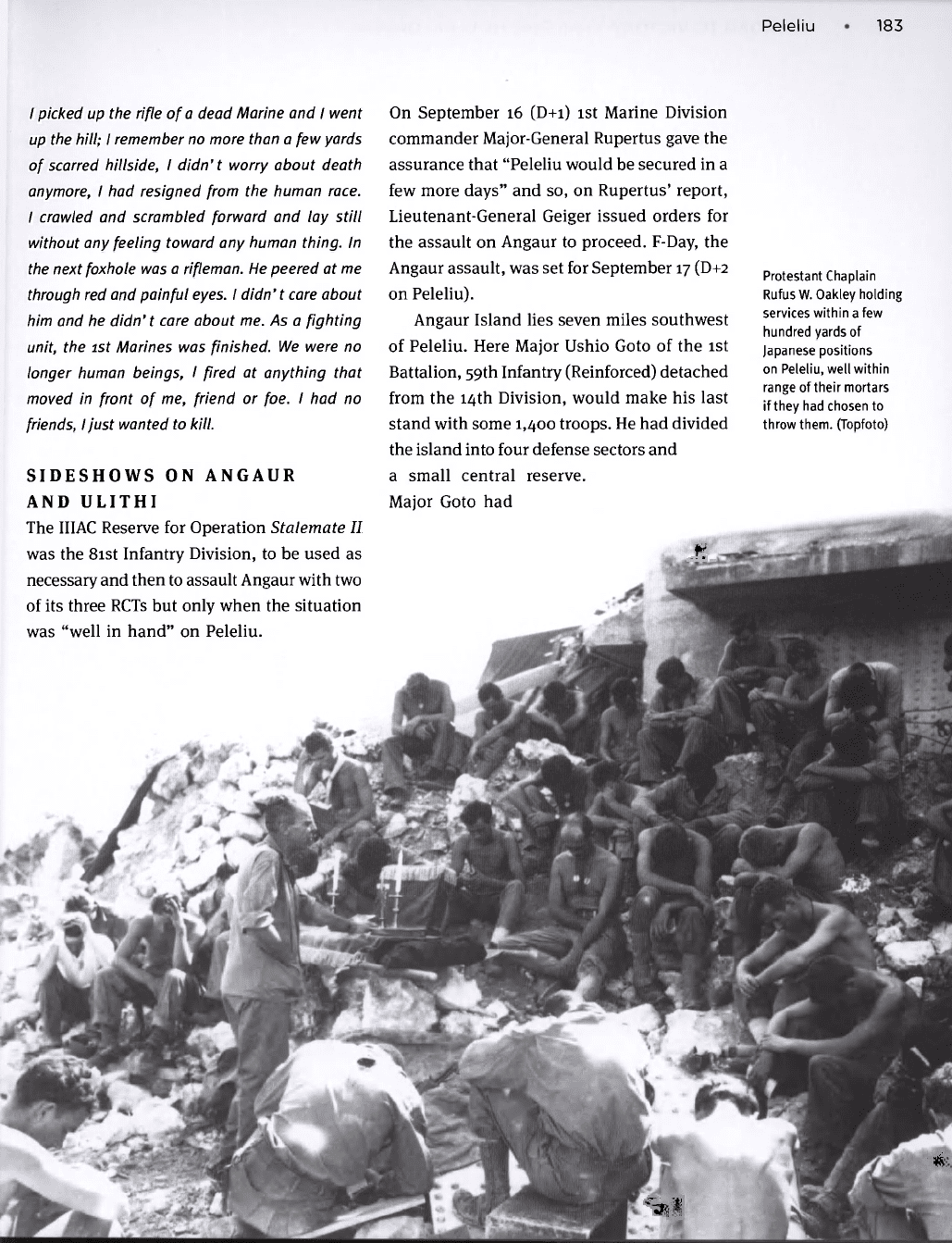
Peleliu • 183
I picked up the
rifle
of
a
dead Marine and I went
up the
hill;
I remember no more than a few yards
of scarred hillside, I didn't worry about death
anymore, I had resigned from the human race.
I crawled and scrambled forward and lay still
without any feeling toward any human thing. In
the next
foxhole was a
rifleman.
He peered at me
through red and painful eyes. I didn't care about
him and he didn't care about me.
/4s
a fighting
unit, the ist Marines was finished. We were no
longer human beings, I fired at anything that
moved in front of me, friend or foe. I had no
friends, I
just wanted to kill.
SIDESHOWS ON ANGAUR
AND ULITHI
The IIIAC Reserve for Operation Stalemate II
was the 8ist Infantry Division, to be used as
necessary and then to assault Angaur with two
of its three RCTs but only when the situation
was "well in hand" on Peleliu.
On September 16 (D+i) 1st Marine Division
commander Major-General Rupertus gave the
assurance that "Peleliu would be secured in a
few more days" and so, on Rupertus' report,
Lieutenant-General Geiger issued orders for
the assault on Angaur to proceed. F-Day, the
Angaur assault, was set for September 17 (D+2
on Peleliu).
Angaur Island lies seven miles southwest
of Peleliu. Here Major Ushio Goto of the 1st
Battalion, 59th Infantry (Reinforced) detached
from the 14th Division, would make his last
stand with some 1,400 troops. He had divided
the island into four defense sectors and
a small central reserve.
Major Goto had
w
Protestant Chaplain
Rufus W. Oakley holding
services within a few
hundred yards of
Japanese positions
on Peleliu, well within
range of their mortars
if they had chosen to
throw them. (Topfoto)
T-l
Wm
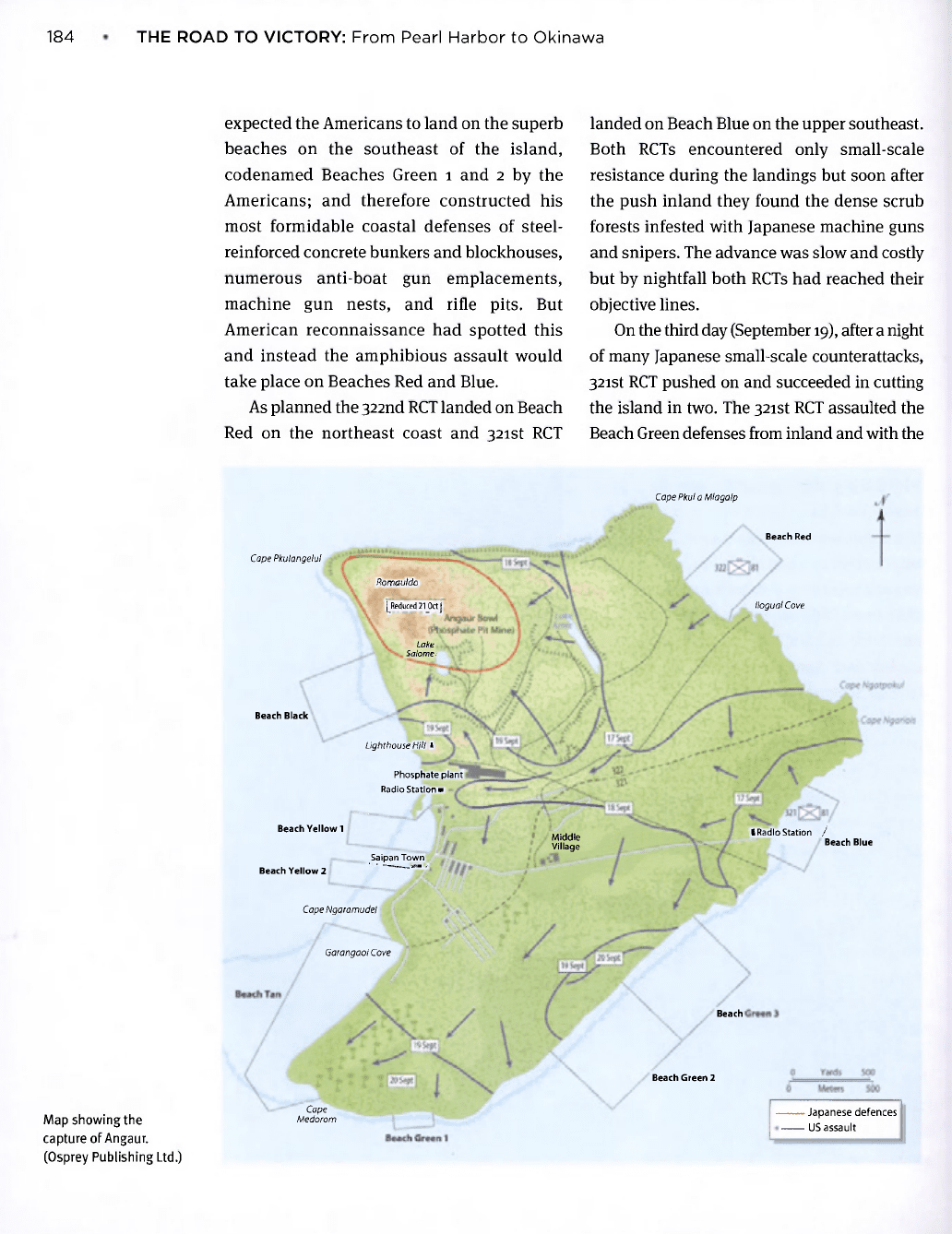
184 • THE ROAD TO VICTORY: From Pearl Harbor to Okinawa
expected the Americans to land on the superb
beaches on the southeast of the island,
codenamed Beaches Green 1 and 2 by the
Americans; and therefore constructed his
most formidable coastal defenses of steel-
reinforced concrete bunkers and blockhouses,
numerous anti-boat gun emplacements,
machine gun nests, and rifle pits. But
American reconnaissance had spotted this
and instead the amphibious assault would
take place on Beaches Red and Blue.
As planned the 322nd RCT landed on Beach
Red on the northeast coast and 321st RCT
landed on Beach Blue on the upper southeast.
Both RCTs encountered only small-scale
resistance during the landings but soon after
the push inland they found the dense scrub
forests infested with Japanese machine guns
and snipers. The advance was slow and costly
but by nightfall both RCTs had reached their
objective lines.
On the third day (September 19), after a night
of many Japanese small-scale counterattacks,
321st RCT pushed on and succeeded in cutting
the island in two. The 321st RCT assaulted the
Beach Green defenses from inland and with the
Cape
Pkul
a Mlagalp
Beach Red
Cape
Pkulangelul
Ronnauldo
[Reduced
2T_0ctj
llogual Cove
Lokt
Salome:
Beach Black
Lighthouse Hill
»
Phosphate plant
Radio Station"
i Radio Station /
Beach Yellow 1
Middle
Village
Beach Blue
Saipan Town
aft
Beach Yellow 2
Cape Ngafamudel
Oarangaoi
Cove
Beach
Beach Green 2
Cape
Medorom
Japanese defences
US assault
Map showing the
capture of Angaur.
(Osprey Publishing Ltd.)
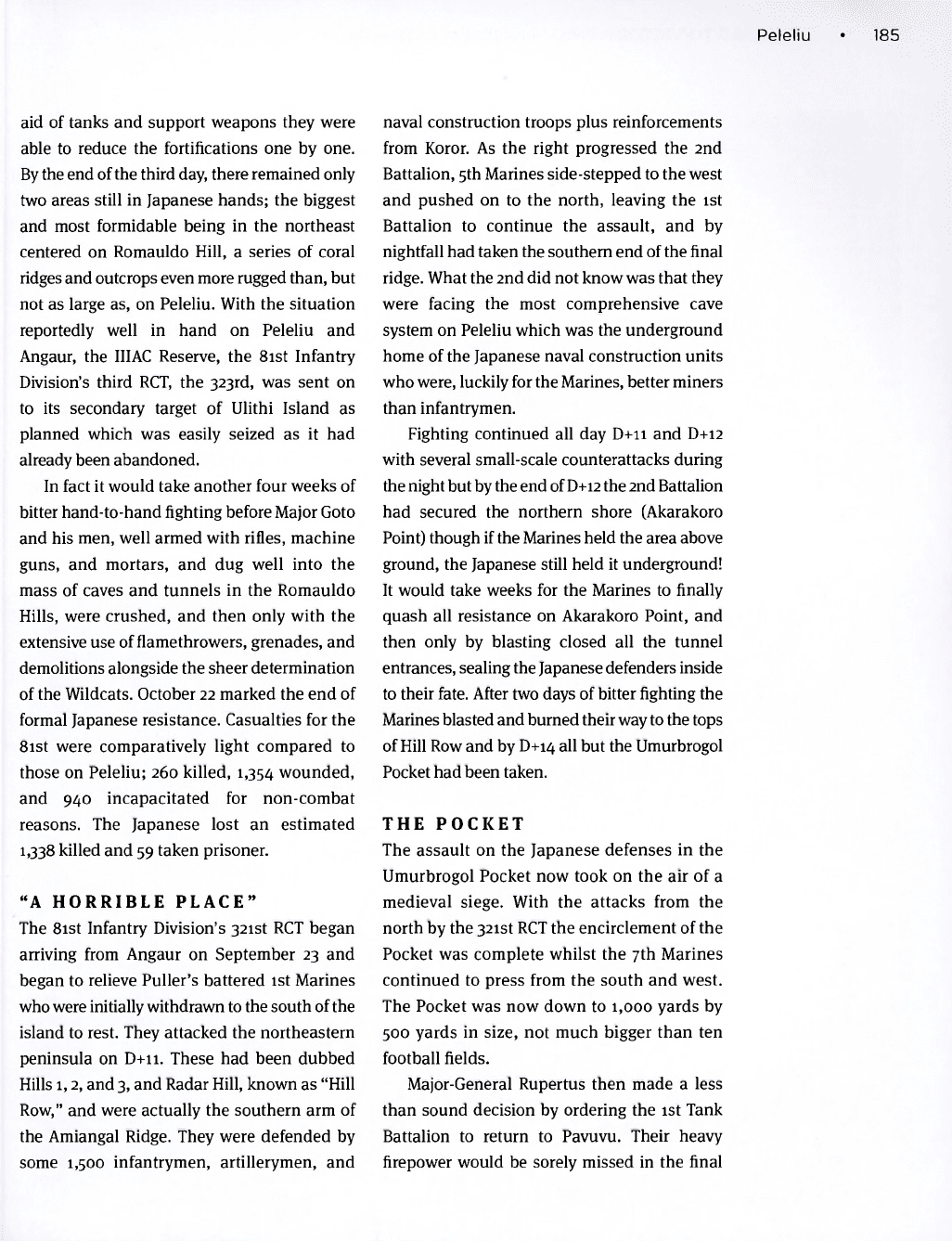
Peleliu • 185
aid of tanks and support weapons they were
able to reduce the fortifications one by one.
By the end of the third day, there remained only
two areas still in Japanese hands; the biggest
and most formidable being in the northeast
centered on Romauldo Hill, a series of coral
ridges and outcrops even more rugged than, but
not as large as, on Peleliu. With the situation
reportedly well in hand on Peleliu and
Angaur, the IIIAC Reserve, the 8ist Infantry
Division's third RCT, the 323rd, was sent on
to its secondary target of Ulithi Island as
planned which was easily seized as it had
already been abandoned.
In fact it would take another four weeks of
bitter hand-to-hand fighting before Major Goto
and his men, well armed with rifles, machine
guns, and mortars, and dug well into the
mass of caves and tunnels in the Romauldo
Hills, were crushed, and then only with the
extensive use of flamethrowers, grenades, and
demolitions alongside the sheer determination
of the Wildcats. October 22 marked the end of
formal Japanese resistance. Casualties for the
81st were comparatively light compared to
those on Peleliu; 260 killed, 1,354 wounded,
and 940 incapacitated for non-combat
reasons. The Japanese lost an estimated
1,338 killed and 59 taken prisoner.
"A HORRIBLE PLACE"
The 81st Infantry Division's 321st RCT began
arriving from Angaur on September 23 and
began to relieve Puller's battered 1st Marines
who were initially withdrawn to the south of the
island to rest. They attacked the northeastern
peninsula on D+11. These had been dubbed
Hills 1,2, and 3, and Radar Hill, known as "Hill
Row," and were actually the southern arm of
the Amiangal Ridge. They were defended by
some 1,500 infantrymen, artillerymen, and
naval construction troops plus reinforcements
from Koror. As the right progressed the 2nd
Battalion, 5th Marines side-stepped to the west
and pushed on to the north, leaving the 1st
Battalion to continue the assault, and by
nightfall had taken the southern end of the final
ridge. What the 2nd did not know was that they
were facing the most comprehensive cave
system on Peleliu which was the underground
home of the Japanese naval construction units
who were, luckily for the Marines, better miners
than infantrymen.
Fighting continued all day D+11 and D+12
with several small-scale counterattacks during
the night but by the end of D+12 the 2nd Battalion
had secured the northern shore (Akarakoro
Point) though if the Marines held the area above
ground, the Japanese still held it underground!
It would take weeks for the Marines to finally
quash all resistance on Akarakoro Point, and
then only by blasting closed all the tunnel
entrances, sealing the Japanese defenders inside
to their fate. After two days of bitter fighting the
Marines blasted and burned their way to the tops
of Hill Row and by D+14 all but the Umurbrogol
Pocket had been taken.
THE POCKET
The assault on the Japanese defenses in the
Umurbrogol Pocket now took on the air of a
medieval siege. With the attacks from the
north by the 321st RCT the encirclement of the
Pocket was complete whilst the 7th Marines
continued to press from the south and west.
The Pocket was now down to 1,000 yards by
500 yards in size, not much bigger than ten
football fields.
Major-General Rupertus then made a less
than sound decision by ordering the 1st Tank
Battalion to return to Pavuvu. Their heavy
firepower would be sorely missed in the final
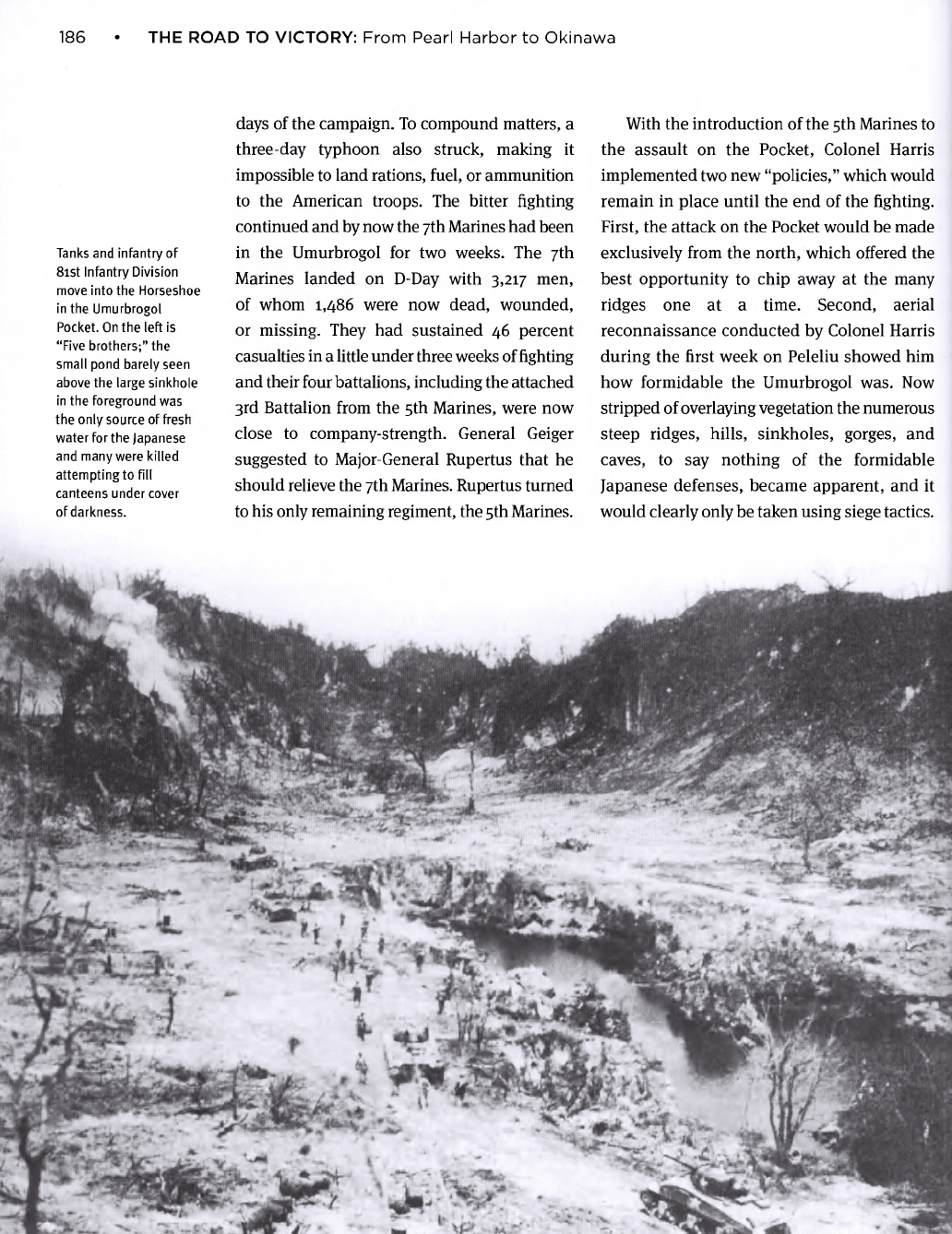
186 • THE ROAD TO VICTORY: From Pearl Harbor to Okinawa
days of the campaign. To compound matters, a With the introduction of the 5th Marines to
three-day typhoon also struck, making it the assault on the Pocket, Colonel Harris
impossible to land rations, fuel, or ammunition implemented two new "policies," which would
to the American troops. The bitter fighting remain in place until the end of the fighting,
continued and by now the 7th Marines had been First, the attack on the Pocket would be made
in the Umurbrogol for two weeks. The 7th exclusively from the north, which offered the
Marines landed on D-Day with 3,217 men, best opportunity to chip away at the many
of whom 1,486 were now dead, wounded, ridges one at a time. Second, aerial
or missing. They had sustained 46 percent reconnaissance conducted by Colonel Harris
casualties in a little under three weeks of fighting during the first week on Peleliu showed him
and their four battalions, including the attached how formidable the Umurbrogol was. Now
3rd Battalion from the 5th Marines, were now stripped of overlaying vegetation the numerous
close to company-strength. General Geiger steep ridges, hills, sinkholes, gorges, and
suggested to Major-General Rupertus that he caves, to say nothing of the formidable
should relieve the 7th Marines. Rupertus turned Japanese defenses, became apparent, and it
to his only remaining regiment, the 5th Marines. would clearly only be taken using siege tactics.
Tanks and infantry of
81st Infantry Division
move into the Horseshoe
in the Umurbrogol
Pocket. On the left is
"Five brothers;" the
small pond barely seen
above the large sinkhole
in the foreground was
the only source of fresh
water for the Japanese
and many were killed
attempting to fill
canteens under cover
of darkness.
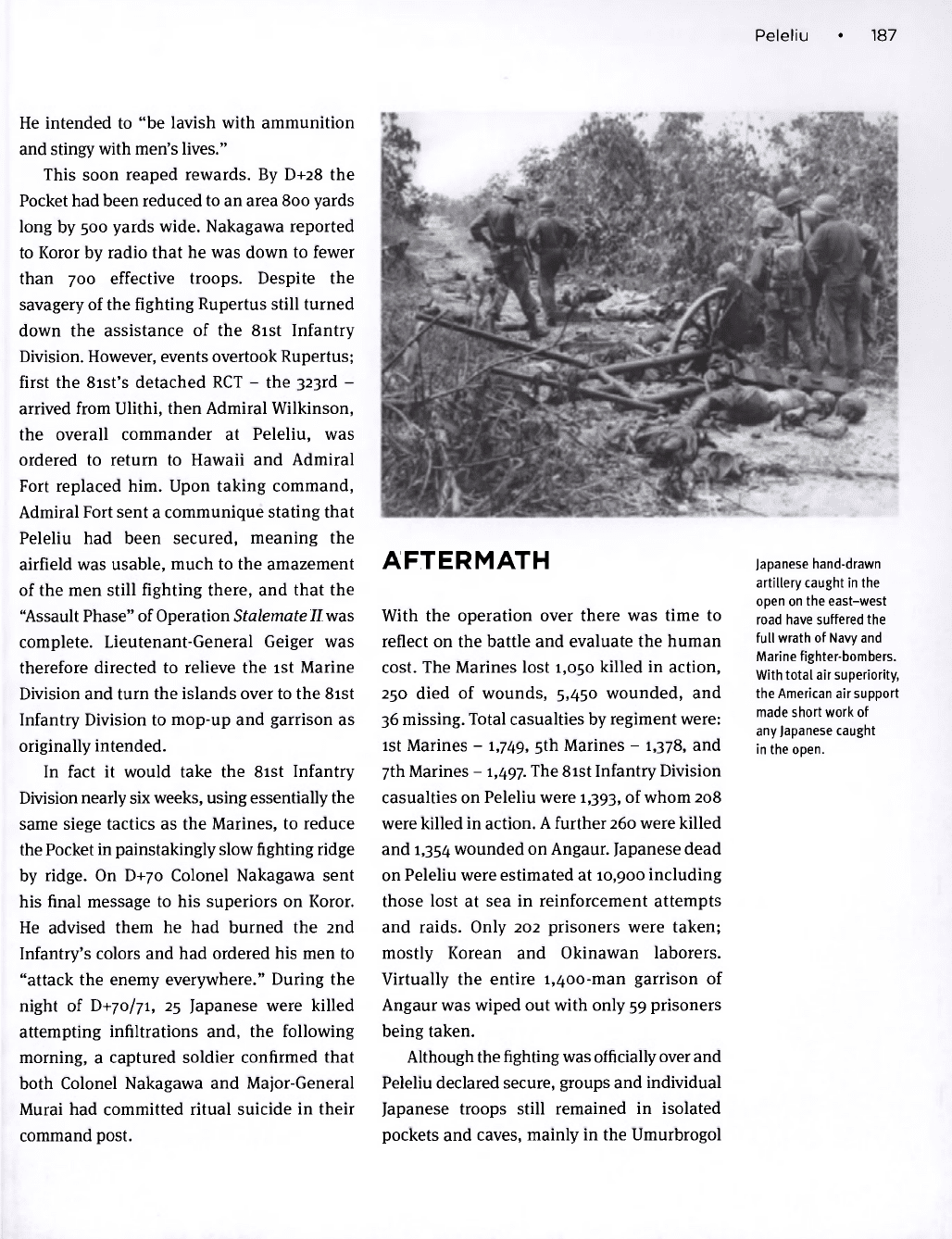
Peleliu • 187
He intended to "be lavish with ammunition
and stingy with men's lives."
This soon reaped rewards. By D+28 the
Pocket had been reduced to an area 800 yards
long by 500 yards wide. Nakagawa reported
to Koror by radio that he was down to fewer
than 700 effective troops. Despite the
savagery of the fighting Rupertus still turned
down the assistance of the 81st Infantry
Division. However, events overtook Rupertus;
first the 8ist's detached RCT - the 323rd -
arrived from Ulithi, then Admiral Wilkinson,
the overall commander at Peleliu, was
ordered to return to Hawaii and Admiral
Fort replaced him. Upon taking command,
Admiral Fort sent a communique stating that
Peleliu had been secured, meaning the
airfield was usable, much to the amazement
of the men still fighting there, and that the
"Assault Phase" of Operation Stalemate II was
complete. Lieutenant-General Geiger was
therefore directed to relieve the 1st Marine
Division and turn the islands over to the 81st
Infantry Division to mop-up and garrison as
originally intended.
In fact it would take the 81st Infantry
Division nearly six weeks, using essentially the
same siege tactics as the Marines, to reduce
the Pocket in painstakingly slow fighting ridge
by ridge. On D+70 Colonel Nakagawa sent
his final message to his superiors on Koror.
He advised them he had burned the 2nd
Infantry's colors and had ordered his men to
"attack the enemy everywhere." During the
night of D+70/71, 25 Japanese were killed
attempting infiltrations and, the following
morning, a captured soldier confirmed that
both Colonel Nakagawa and Major-General
Murai had committed ritual suicide in their
command post.
AFTERMATH
With the operation over there was time to
reflect on the battle and evaluate the human
cost. The Marines lost 1,050 killed in action,
250 died of wounds, 5,450 wounded, and
36 missing. Total casualties by regiment were:
1st Marines - 1,749, 5th Marines - 1,378, and
7th Marines - 1,497. The 81st Infantry Division
casualties on Peleliu were 1,393, of whom 208
were killed in action. A further 260 were killed
and 1,354 wounded on Angaur. Japanese dead
on Peleliu were estimated at 10,900 including
those lost at sea in reinforcement attempts
and raids. Only 202 prisoners were taken;
mostly Korean and Okinawan laborers.
Virtually the entire 1,400-man garrison of
Angaur was wiped out with only 59 prisoners
being taken.
Although the fighting was officially over and
Peleliu declared secure, groups and individual
Japanese troops still remained in isolated
pockets and caves, mainly in the Umurbrogol
Japanese hand-drawn
artillery caught in the
open on the east-west
road have suffered the
full wrath of Navy and
Marine fighter-bombers.
With total air superiority,
the American air support
made short work of
any Japanese caught
in the open.
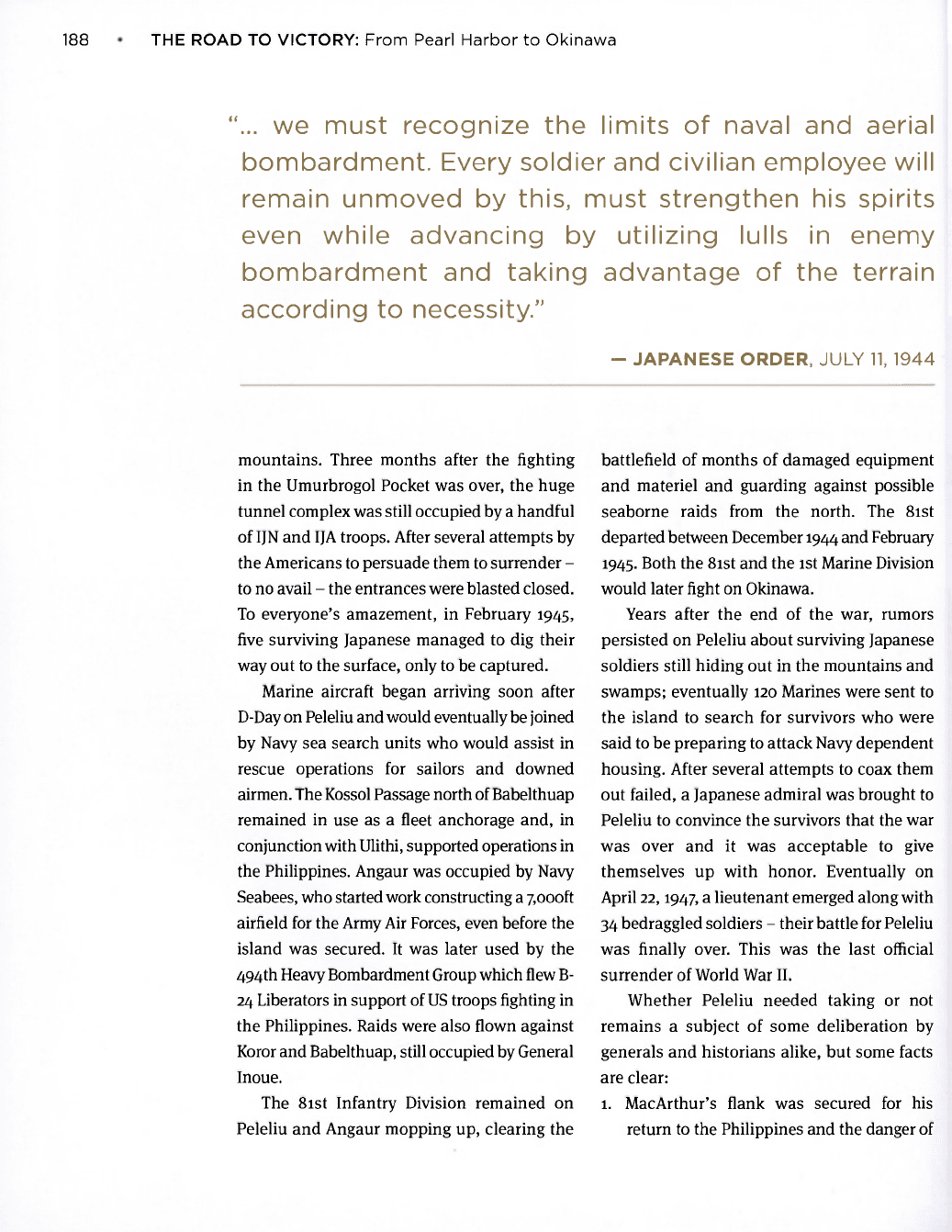
188 • THE ROAD TO VICTORY: From Pearl Harbor to Okinawa
"... we must recognize the limits of naval and aerial
bombardment. Every soldier and civilian employee will
remain unmoved by this, must strengthen his spirits
even while advancing by utilizing lulls in enemy
bombardment and taking advantage of the terrain
according to necessity."
- JAPANESE ORDER, JULY 11, 1944
mountains. Three months after the fighting
in the Umurbrogol Pocket was over, the huge
tunnel complex was still occupied by a handful
of IJN and IJA troops. After several attempts by
the Americans to persuade them to surrender -
to no avail - the entrances were blasted closed.
To everyone's amazement, in February 1945,
five surviving Japanese managed to dig their
way out to the surface, only to be captured.
Marine aircraft began arriving soon after
D-Day on Peleliu and would eventually be joined
by Navy sea search units who would assist in
rescue operations for sailors and downed
airmen. The Kossol Passage north of Babelthuap
remained in use as a fleet anchorage and, in
conjunction with Ulithi, supported operations in
the Philippines. Angaur was occupied by Navy
Seabees, who started work constructing a 7,000ft
airfield for the Army Air Forces, even before the
island was secured. It was later used by the
494th Heavy Bombardment Group which flew B-
24 Liberators in support of US troops fighting in
the Philippines. Raids were also flown against
Koror and Babelthuap, still occupied by General
Inoue.
The 81st Infantry Division remained on
Peleliu and Angaur mopping up, clearing the
battlefield of months of damaged equipment
and materiel and guarding against possible
seaborne raids from the north. The 81st
departed between December 1944 and February
1945. Both the 81st and the 1st Marine Division
would later fight on Okinawa.
Years after the end of the war, rumors
persisted on Peleliu about surviving Japanese
soldiers still hiding out in the mountains and
swamps; eventually 120 Marines were sent to
the island to search for survivors who were
said to be preparing to attack Navy dependent
housing. After several attempts to coax them
out failed, a Japanese admiral was brought to
Peleliu to convince the survivors that the war
was over and it was acceptable to give
themselves up with honor. Eventually on
April 22,1947, a lieutenant emerged along with
34 bedraggled soldiers - their battle for Peleliu
was finally over. This was the last official
surrender of World War II.
Whether Peleliu needed taking or not
remains a subject of some deliberation by
generals and historians alike, but some facts
are clear:
1. MacArthur's flank was secured for his
return to the Philippines and the danger of
